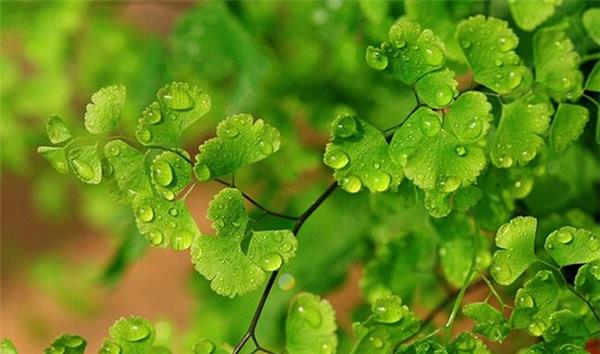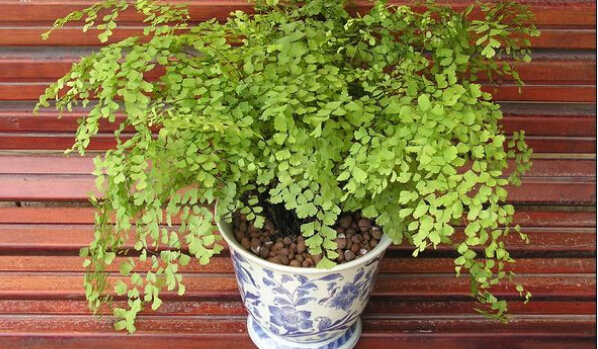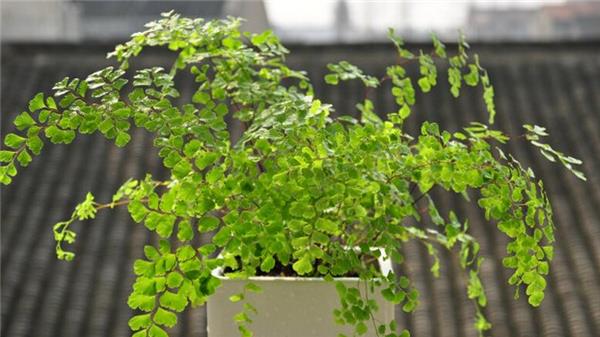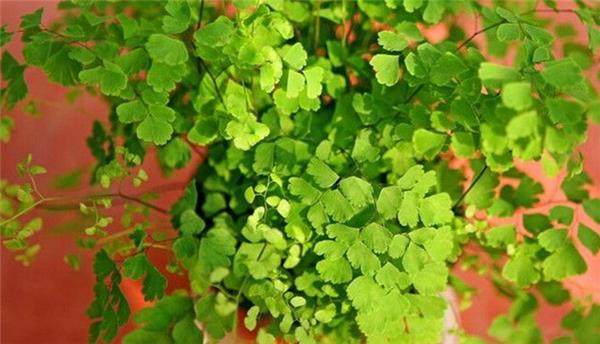Must see the cultivation method of Dryopteris Dryopteris at home what are the exquisite ways to feed Dryopteris?
Dryopteris (scientific name: Adiantumcapillus-venerisLinn.) Is a perennial evergreen herb, also known as iron wire grass, girl's hair, clematis, water pig hairy soil. Its light green thin leaves with jet-black and shiny petioles are particularly elegant and elegant. 0.1-0.5 meters high. It is named Dryopteris Dryopteris because of its slender stem and color like iron wire. Dryopteris is also an indicator of calcareous soil. Because of its fear of dryness and strong light, it must be placed in a place where there is no direct sunlight for maintenance. There are also many varieties of Dryopteris Dryopteris, such as Dryopteris przewalskii, Dryopteris renifolia and so on. It belongs to the species of the world and is wild in all regions. So, what is the breeding method of iron wire Jue?

1. Soil: Dryopteris likes loose, permeable and fertile calcareous sandy loam. when potted, the cultivated soil can be mixed with loam, rotten leaf soil and river sand.
2. Watering: the fern likes the humid environment and should be fully watered in the peak growing season. In addition to keeping the basin soil moist, we should also pay attention to the high air humidity and sprinkle water around the plant when the air is dry. Especially in summer, water should be watered 1-2 times a day. If there is a lack of water, it will cause the leaves to shrink. Watering taboo basin soil when dry and sometimes wet, easy to make the leaves yellow.
3. Sunshine: like bright scattered light, afraid of direct sunlight. If the light is too strong, the leaves will be withered and yellow or even die, which can be properly shaded in summer, and most of the leaves will be withered and yellow if the strong light is directed for a long time. It should be placed in a dark place indoors, and it can grow normally even if it is placed for 1 year.
4. Temperature: like warmth and cold resistance, the suitable temperature for growth is 21-25 ℃ in daytime and 12-15 ℃ at night. In winter, the leaves can keep fresh green when the temperature is above 5 ℃, but frost injury will occur when the temperature is lower than 5 ℃.
5, fertilization: apply thin liquid fertilizer 2-3 times a month, do not stain the leaf surface, so as not to cause rotten leaves, because of the calcium-loving habit of Dryopteris, the basin soil should add appropriate amount of lime and broken eggshell, and the effect of calcareous fertilizer will be better. In winter, we should reduce watering and stop fertilizing.
6. Insect pests: potted Dryopteris Dryopteris, often with leaf blight, can be controlled with Bordeaux solution at the initial stage, and 70% methyl topiramate 1000-1500 times in severe cases. If the plant is damaged by scale insects, 40% omethoate 1000 times solution can be used for control.

7. Pruning: after autumn, as the temperature drops, Dryopteris will grow slowly, and the old leaves will gradually turn yellow, so cut them off.
Dryopteris is a common potted plant in the home, green, simple breeding, suitable for indoor display, the breeding methods of Dryopteris are summarized here, then, how to manage the four seasons of Dryopteris.
Four Seasons Management of Dryopteris Culture
(1) Spring management
The pots of Dryopteris can be changed in April, and the pots can be changed once a year. Dryopteris likes yin and dampness and is afraid of strong light. There should be appropriate morning and evening light in early spring, and spring should be arranged in a room with bright scattered light.
After Dryopteris begins to grow in spring, attention should be paid to the management of water and fertilizer. When decorating indoors, special attention should be paid to increasing indoor air humidity. Improving indoor air humidity is the key to family cultivation of Dryopteris. Daily application of ferrous sulfate can not only increase the acidity of the soil, is conducive to its growth, but also make the leaves more green.
(2) Summer management
The high temperature, strong light and dry climate in summer are not suitable for the growth of Dryopteris. It should be cultivated in a brightly lit place indoors to keep the basin soil moist and spray around it to improve air humidity. Do not apply fertilizer when the temperature is hot. The iron fern is afraid of the wind and should not be placed in front of the electric fan and the air outlet of the air conditioner. The air humidity of the air conditioned room is lower, so the number of sprays should be increased.

(3) Autumn management
Dryopteris can still grow normally in autumn, so attention should be paid to the management of water and fertilizer. After the temperature drops at the end of autumn, we should pay attention to maintain the indoor temperature, gradually reduce the amount of water, make the basin soil moist, and gradually move it to a place with morning and evening light for cultivation.
(4) Winter management
Dryopteris is not resistant to cold and should be kept above 5 ℃ at room temperature. At this time, the growth of Dryopteris is stagnant, and the leaves are dark green, which can appropriately increase the light in the morning and evening (avoid the strong light at noon) and water less, so that the basin soil is partial to and does not apply fertilizer.
When the indoor temperature is kept above 10%, the fern grows better, the leaves are bright green, and the basin soil should be kept moist, but not fertilized. When the indoor temperature is higher, the air humidity will be correspondingly lower, so we should pay attention to supplement the air humidity.
For the table table of the living room, it is appropriate to use mini foliage potted plants, such as choosing potted plants with a caliber of 3'4 (pot diameter of 9'12'm), and the height of the stem is 5'6'm. Among these mini potted plants, the most characteristic species are dragon blood trees (thousand-year-old wood, palm wood, tortoise back bamboo, Xilin taro, pocket coconut, ivy, iron fern, deer horn fern, powder vine, etc.). So, what are the points for attention in Dryopteris culture?

1. Although the indoor light is not too dark at ordinary times, the general indoor light is still a little darker for Dryopteris, so it is best to put it in a bright light.
2. Dryopteris prefers cool climate. The growth temperature is between 15 ℃ and 25 ℃. The temperature of leaves should not be lower than 7 ℃, otherwise the leaves may be frostbitten.
3. Dryopteris likes the environment with high humidity very much, so it should be watered 4 or 5 times a day in spring, summer and autumn.
4. Fertilization is necessary for Dryopteris, but according to the principle of "small amount and more application", 1000-2000 times diluent such as Huabao can be used.
5. Dryopteris likes warm, humid and semi-cold environment and hates direct sunlight very much.
6. Ferns grow in a humid environment, and for Dryopteris Dryopteris, it is no exception.
7. The pot needs to be changed once every spring, and the dried leaves and old roots should be trimmed at the same time.

After reading this article, I believe you must have a deeper understanding of how to raise Dryopteris and the breeding method of Dryopteris. As long as we follow scientific breeding methods and careful maintenance, we will be able to grow beautiful and colorful ferns. The above is the introduction about how to raise Dryopteris and the breeding methods of Dryopteris. I hope it can be helpful to everyone.
1. Although the indoor light is not too dark at ordinary times, the general indoor light is still a little darker for Dryopteris, so it is best to put it in a bright light.
2. Dryopteris prefers cool climate. The growth temperature is between 15 ℃ and 25 ℃. The temperature of leaves should not be lower than 7 ℃, otherwise the leaves may be frostbitten.
3. Dryopteris likes the environment with high humidity very much, so it should be watered 4 or 5 times a day in spring, summer and autumn.
4. Fertilization is necessary for Dryopteris, but according to the principle of "small amount and more application", 1000-2000 times diluent such as Huabao can be used.
5. Dryopteris likes warm, humid and semi-cold environment and hates direct sunlight very much.
6. Ferns grow in a humid environment, and for Dryopteris Dryopteris, it is no exception.
7. The pot needs to be changed once every spring, and the dried leaves and old roots should be trimmed at the same time.

After reading this article, I believe you must have a deeper understanding of how to raise Dryopteris and the breeding method of Dryopteris. As long as we follow scientific breeding methods and careful maintenance, we will be able to grow beautiful and colorful ferns. The above is the introduction about how to raise Dryopteris and the breeding methods of Dryopteris. I hope it can be helpful to everyone.
- Prev

Introduction to the breeding methods of cyclamen that should not be missed.
Introduction to the breeding methods of cyclamen that should not be missed.
- Next

The culture method of geranium how to raise healthy and beautiful geranium
The culture method of geranium how to raise healthy and beautiful geranium
Related
- Wuhan Hospital Iron Tree Blooming Result Was Instantly Frightened by the Gardener Master
- Which variety of camellia is the most fragrant and best? Which one do you like best?
- What is the small blue coat, the breeding methods and matters needing attention of the succulent plant
- Dormancy time and maintenance management of succulent plants during dormancy
- Minas succulent how to raise, Minas succulent plant pictures
- What are the varieties of winter succulent plants
- How to raise succulent plants in twelve rolls? let's take a look at some experience of breeding twelve rolls.
- Attention should be paid to water control for succulent plants during dormant period (winter and summer)
- Watering experience of twelve rolls of succulent plants
- Techniques for fertilizing succulent plants. An article will let you know how to fertilize succulent plants.

